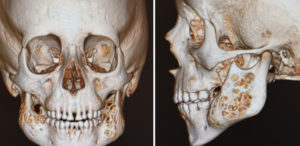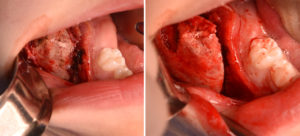Background: Cherubism is a very rare genetic disorder that primarily affects the shape of the lower jaw bone. The painless ‘swelling’ of the lower jaw creates a fullness that appears like an extreme form of mumps and. as a s result, the chubby facial appearance is equated to that of cherubs as often seen in paintings of biblical times and the heavens.
The facial chubbiness comes from the overgrowth of the jaw. The patient’s face becomes enlarged and disproportionate due to the fibrous tissue and atypical bone formation. It creates expansile growth of the ramus of the mandible primarily. It expands out both sides of the cortical covering of the ramus and replaces it with fibrous tissue and cyst-like formations. The reason that this extensive fibro-osseous growth occurs is not known but an imbalance between the normal osteoclastic and osteoblastic remodeling of the bone with growth is altered. It has been linked to a genetic mutation of the SH3BP2 gene on chromosome 4p16.3.
It is an autosomal dominant disorder which occurs primarily in males. It usually appears in childhood at around age 5 or 6. It will continue to grow until puberty when many affected patients stabilize and the abnormal bone growth ceases. In more mild cases the expanded bone may return to a normal bone shape and facial appearance. But in more moderate and severe cases this does not occur. In more severe cases the jaw growth goes unchecked and continues to deform the face.
The only treatment for cherubim is surgical excision of the affected bone. The cortical bone separates easily and exposes the now fibrous and cystic diploid space. Care must be taken in removing this soft soupy fibrous tissue to not injure unerupted teeth and the inferior alveolar nerve.


Cherubism is rarely seen let alone surgically treated. Surgery to do a subtotal resection of the excessive fibro-osseous tissue is a low risk procedure that may either prevent further disease progression or hasten an earlier resolution of it.
Highlights:
1) Cherubism is a very rare cranofacial disorder that primarily affects the lower jaw.
2) Surgical treatment may be indicated when the degree of facial disfigurement is source of emotional distress and is progressive.
3) Intraoral subtotal resection of cherubism is the preferred technique to avoid external facial scarring.
Dr. Barry Eppley
Indianapolis, Indiana




